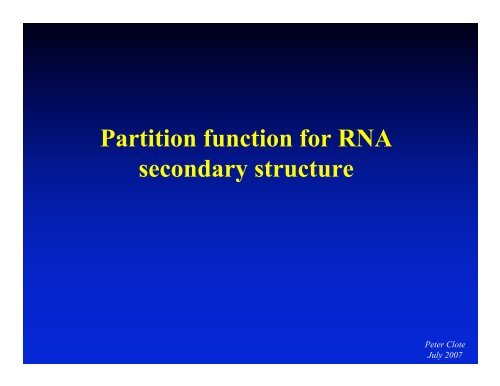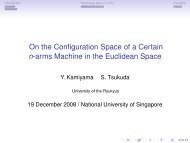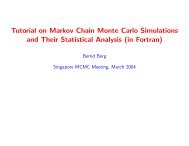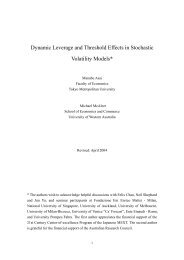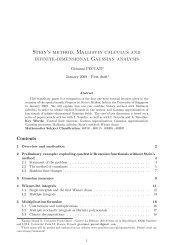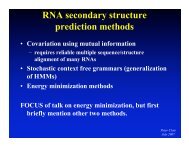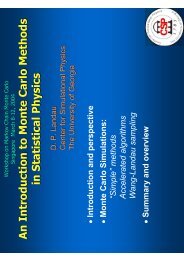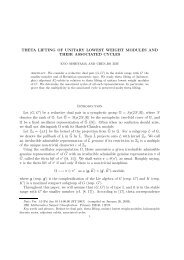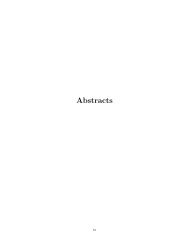Partition function for RNA secondary structure
Partition function for RNA secondary structure
Partition function for RNA secondary structure
Create successful ePaper yourself
Turn your PDF publications into a flip-book with our unique Google optimized e-Paper software.
<strong>Partition</strong> <strong>function</strong> <strong>for</strong> <strong>RNA</strong><br />
<strong>secondary</strong> <strong>structure</strong><br />
Peter Clote<br />
July 2007
Boltzmann probability of sequence<br />
alignment<br />
Peter Clote<br />
July 2007
McCaskill’s Algorithm<br />
Peter Clote<br />
July 2007
Peter Clote<br />
July 2007
Peter Clote<br />
July 2007
Peter Clote<br />
July 2007
Peter Clote<br />
July 2007
Peter Clote<br />
July 2007
Peter Clote<br />
July 2007
Probability that i,j base pair<br />
(Nussinov-Jacobson energy model)<br />
Peter Clote<br />
July 2007
McCaskill’s algorithm base pairing probabilities<br />
<strong>for</strong> Ala-t<strong>RNA</strong> using Vienna <strong>RNA</strong> package<br />
Peter Clote<br />
July 2007
Peter Clote<br />
July 2007
Peter Clote<br />
July 2007
Peter Clote<br />
July 2007
Peter Clote<br />
July 2007
Peter Clote<br />
July 2007
Peter Clote<br />
July 2007
Peter Clote<br />
July 2007
Peter Clote<br />
July 2007
Peter Clote<br />
July 2007
Peter Clote<br />
July 2007
McCaskill’s algorithm <strong>for</strong> Turner<br />
energy model<br />
Dirks, Pierce, “A partition <strong>function</strong> algorithm <strong>for</strong> nucleic acid <strong>secondary</strong> <strong>structure</strong><br />
including pseudoknotsJ Comput Chem, 24(13):1664-1677, 2003<br />
Peter Clote<br />
July 2007
Dirks, Pierce, “A partition <strong>function</strong> algorithm <strong>for</strong> nucleic acid <strong>secondary</strong> <strong>structure</strong><br />
including pseudoknots”, J Comput Chem, 24(13):1664-1677, 2003<br />
Peter Clote<br />
July 2007
Dirks, Pierce, “A partition <strong>function</strong> algorithm <strong>for</strong> nucleic acid <strong>secondary</strong> <strong>structure</strong><br />
including pseudoknotsJ Comput Chem, 24(13):1664-1677, 2003<br />
Peter Clote<br />
July 2007
Dirks, Pierce, “A partition <strong>function</strong> algorithm <strong>for</strong> nucleic acid <strong>secondary</strong> <strong>structure</strong> including pseu<br />
J Comput Chem, 24(13):1664-1677, 2003<br />
Peter Clote<br />
July 2007
Lyngsø and Pederson, <strong>RNA</strong> pseudoknot prediction in energybased models,<br />
J. Comput. Biol., 7:409-427 (2000)<br />
Peter Clote<br />
July 2007
Dirks, Pierce, “A partition <strong>function</strong> algorithm <strong>for</strong> nucleic acid <strong>secondary</strong> <strong>structure</strong><br />
including pseudoknots”, J Comput Chem, 24(13):1664-1677, 2003<br />
Peter Clote<br />
July 2007
Energy minimization <strong>for</strong> several<br />
species<br />
• “Prediction of hybridization and melting <strong>for</strong><br />
double-stranded nucleic acids”, Dimitrov, Zuker,<br />
Biophysical Journal 87:215-226 (2004) –<br />
computation of Boltzmann partition <strong>function</strong><br />
• “Secondary <strong>structure</strong> prediction of interacting<br />
<strong>RNA</strong> molecules”, Andronescu, Zhang, Condon,<br />
JMB 345:987-1001 (345)<br />
Peter Clote<br />
July 2007
Applications of Boltzmann<br />
partition <strong>function</strong>
• Base pairs (i,j) with high Boltzmann pair<br />
probabilities are more likely to be in the<br />
phylogenetic <strong>structure</strong> (comparative sequence<br />
analysis) – observation of D. Mathews in <strong>RNA</strong><br />
10:1178-1190 (2004)<br />
• Similar to observation of Vingron and Argos that<br />
positions i,j in optimal pairwise sequence alignment<br />
with high Boltzmann probability are biologically<br />
relevant positions.<br />
Peter Clote<br />
July 2007
Higher probability base pairs are more<br />
likely to be in phylogenetic <strong>structure</strong><br />
Mathews, Using an <strong>RNA</strong> <strong>secondary</strong> <strong>structure</strong> partition <strong>function</strong> to<br />
determine confidence in base pairs predicted by free energy minimization,<br />
<strong>RNA</strong> 10:1178-1190 (2004)<br />
Peter Clote<br />
July 2007
Mathews, Using an <strong>RNA</strong> <strong>secondary</strong> <strong>structure</strong> partition <strong>function</strong> to<br />
determine confidence in base pairs predicted by free energy minimization,<br />
<strong>RNA</strong> 10:1178-1190 (2004)<br />
Peter Clote<br />
July 2007
Mathews, Using an <strong>RNA</strong> <strong>secondary</strong> <strong>structure</strong> partition <strong>function</strong> to<br />
determine confidence in base pairs predicted by free energy minimization,<br />
<strong>RNA</strong> 10:1178-1190 (2004)<br />
Peter Clote<br />
July 2007
Sampling <strong>RNA</strong> <strong>structure</strong>s<br />
• Y. Ding, C.E. Lawrence, Computers & Chemistry 23<br />
(1999) 387-400 use Bayesian method to sample number of<br />
loops, stacking energy tables, and <strong>secondary</strong> <strong>structure</strong>s<br />
using the full Turner energy model.<br />
• Simplified IDEA <strong>for</strong> Nussinov-Jacobson model uses<br />
recursive sampling procedure, which<br />
given sequence<br />
i,i+1,...,j<br />
decides if j is unpaired, paired with i or paired with<br />
intermediate i
• Pr[j is unpaired]<br />
Z i,j-1 /Z i,j<br />
• Pr[j paired with i]<br />
e -a(i,j)/RT Z i+1,j-1 /Z i,j<br />
• Pr[j paired with k]<br />
e -a(k,j)/RT Z i,k-1 Z k+1,j-1 /Z i,j<br />
Peter Clote<br />
July 2007
Peter Clote<br />
July 2007
Peter Clote<br />
July 2007
Sfold – Ding’s software <strong>for</strong><br />
sampling <strong>RNA</strong>s<br />
http://sfold.wadsworth.org/index.pl<br />
Peter Clote<br />
July 2007
Applications of sampling<br />
(Ding-Lawrence)<br />
• Determination of probability that i,i+1,i+2,i+3 is NOT<br />
base paired in the statistical ensemble of 1000 samples.<br />
Such regions, if they additionally satisfy Tuschl’s rules<br />
are potential targets <strong>for</strong> <strong>RNA</strong>i<br />
• Determination of probability that i is in a hairpin loop,<br />
etc.<br />
• Improve <strong>RNA</strong> <strong>secondary</strong> <strong>structure</strong> prediction by finding<br />
centroid of cluster of sampled <strong>structure</strong>s. Ding, Chan,<br />
Lawrence, <strong>RNA</strong> <strong>secondary</strong> <strong>structure</strong> by centroids in a<br />
Boltzmann weighted ensemble, <strong>RNA</strong> (2005).<br />
Peter Clote<br />
July 2007
Vienna <strong>RNA</strong> Package predicted <strong>structure</strong><br />
<strong>for</strong> Ala-t<strong>RNA</strong> from M. jannaschii<br />
Peter Clote<br />
July 2007
Sample output from Sfold<br />
Peter Clote<br />
July 2007
McCaskill’s algorithm base pairing probabilities<br />
<strong>for</strong> Ala-t<strong>RNA</strong> using Vienna <strong>RNA</strong> package<br />
Peter Clote<br />
July 2007
Sampled base pair histogram from<br />
1000 sampled Ala-t<strong>RNA</strong> <strong>structure</strong>s using Sfold<br />
Peter Clote<br />
July 2007
Probability profile of Ala-t<strong>RNA</strong><br />
using Sirna from Sfold<br />
Peter Clote<br />
July 2007
Hairpin frequency in Ala-t<strong>RNA</strong><br />
samples using Sirna from Sfold<br />
Peter Clote<br />
July 2007
Bulge frequency in Ala-t<strong>RNA</strong><br />
samples using Sirna from Sfold<br />
Peter Clote<br />
July 2007
Boltzmann centroids<br />
Ding, Chan, Lawrence, <strong>RNA</strong> <strong>secondary</strong> <strong>structure</strong> by centroids in a<br />
Boltzmann weighted ensemble, to appear in <strong>RNA</strong> (2005).<br />
Peter Clote<br />
July 2007
Ding, Chan, Lawrence, <strong>RNA</strong> <strong>secondary</strong> <strong>structure</strong> by centroids in a<br />
Boltzmann weighted ensemble, to appear in <strong>RNA</strong> (2005).<br />
Peter Clote<br />
July 2007
Ding, Chan, Lawrence, <strong>RNA</strong> <strong>secondary</strong> <strong>structure</strong> by centroids in a<br />
Boltzmann weighted ensemble, to appear in <strong>RNA</strong> (2005).<br />
Peter Clote<br />
July 2007
Ding, Chan, Lawrence, <strong>RNA</strong> <strong>secondary</strong> <strong>structure</strong> by centroids in a<br />
Boltzmann weighted ensemble, to appear in <strong>RNA</strong> (2005).<br />
Peter Clote<br />
July 2007
Ding, Chan, Lawrence, <strong>RNA</strong> <strong>secondary</strong> <strong>structure</strong> by centroids in a<br />
Boltzmann weighted ensemble, to appear in <strong>RNA</strong> (2005).<br />
Peter Clote<br />
July 2007
Ding, Chan, Lawrence, <strong>RNA</strong> <strong>secondary</strong> <strong>structure</strong> by centroids in a<br />
Boltzmann weighted ensemble, to appear in <strong>RNA</strong> (2005).<br />
Peter Clote<br />
July 2007
Ding, Chan, Lawrence, <strong>RNA</strong> <strong>secondary</strong> <strong>structure</strong> by centroids in a<br />
Boltzmann weighted ensemble, to appear in <strong>RNA</strong> (2005).<br />
Peter Clote<br />
July 2007


